| Mysterious Artifacts | |
| Written by AnubisTTP on 2008-12-25 |
|
Occasionally we do encounter something we've never seen before. This is a collection of some of the strangest and most mysterious items we have found over the years, along with what little information we have managed to glean from packaging and careful examination. Can you identify any of these strange components?
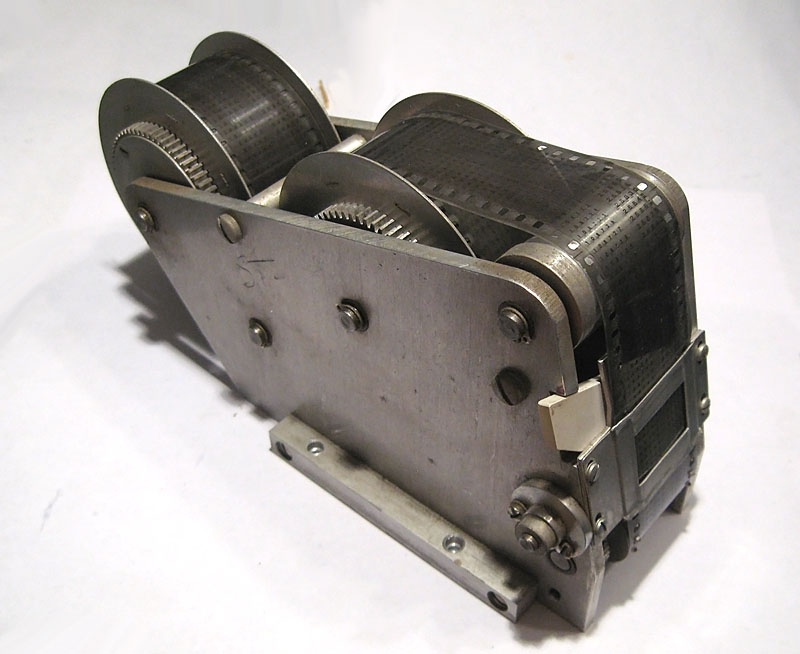
This object is obviously some sort of display device, but it's intended function is mysteriously cryptic. The display mechanism consists of two mechanically linked aluminum drums, on which a substantial length of 35mm film has been spooled. The film is held under tension and printed with a series of 5 and 6 digit numbers, which can be read through a back-lit window on the front of the device. A flex shaft located on one side of the display allows it to be connected to a potentiometer or other rotary input.
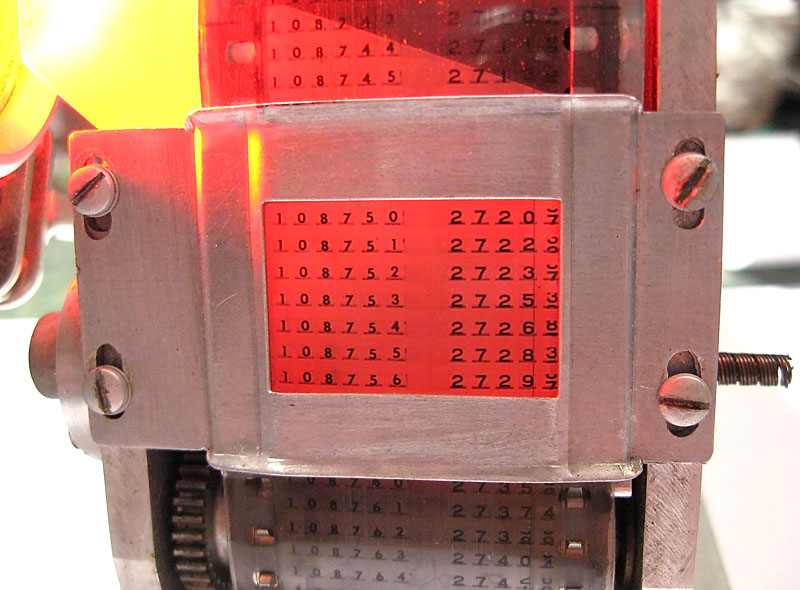
This display does not seem to be able to display anything useful. The viewing window shows a large range of sequential numbers at a time and the rightmost number seems to increment at a random and useless interval. There are no manufacturers marks or serial numbers anywhere on the the device. Perhaps a propbuilder would find this display useful if they were trying to replicate the DNA machine from Blade Runner 2049, but that does little to explain why this contraption exists in our non-dystopian reality.
Special thanks to Poul-Henning Kamp for identifying the above device: "Your Mystery device, the top one at least, is a film scale probably for a frequency generator. This was a very common way to deal with the inherent nonlinearieties in electronics back before everything got quartz stabilized. See BSTJ September 1956 page 1148: "The Calibrating Machine for 56-A Oscillator Film Scales".

This object is obviously some sort of hybrid integrated circuit, but apparently has been enclosed in one of the most bizarre packages ever to be birthed by the semiconductor industry. The device is constructed on a completely unusual five-sided ceramic wafer, with gold and ceramic lead frames exiting from two of the five faces. Instead of a typical cavity lid, the internals of this device are protected by a pentagonal plastic ring filled with clear epoxy, which leaves the internals fully visible. We have no idea why a company would package a chip in this way; perhaps the device contains light-sensitive elements, or requires visual inspection by a human operator.

Under high magnification, the device appears to contain a single integrated circuit, as well as an eclectic medley of bare-die transistors and diodes. Strangely, these delicate components are sharing space with a number of apparently mundane surface-mount resistors and capacitors.

This is almost certainly some sort of integrated circuit, but its function and purpose are a total mystery. A search for 'Beckman 809-V6' on Google yields nothing but worthless part-miner services, and the somewhat cryptic labeling is of no assistance; we feel it unlikely that many helical potentiometers were released in white ceramic hybrid DIP packages.
Special thanks to Corey Hatch for identifying the above device: "Regarding items in your "Mysterious Artifacts" section, the Beckman 809-V6 is a hybrid microcircuit, and is a linear 6V voltage regulator. Ei and Eo are the voltage input/outputs, used in connection with COM. The T pin is used at the factory for output voltage tailoring (one or several thick-film resistors are laser tailored whilst measuring at that pin before the alumina lid is hermetically sealed in place. The other pins are used as needed as per the application circuit. Other vendors appear to still be offering these, as I noticed you too, have some for sale. While I don't own any of the 809 parts personally, I do posses some 827-V6 Mi-Crobar parts, which are 6V SCR crowbars."

Another mystery integrated circuit, these anonymous devices are packaged in an unusual white ceramic quad-inline package with gold pads. They came housed in a plastic carrier with a handwritten label stating the following; "5 CDC^68 samples wired with 31.75 um wire. Beware when opening, samples without lid". We were told that these devices were some sort of CCD, and they indeed have a large gold heat-spreader on the back like some other CCD part numbers, but the die within looks like no CCD that we have ever seen.

An image of the alleged CCD die from the device above, taken at 20x magnification. The die is divided into 56 rectangular sectors, each filled with a fine tracery of integrated circuit material. If this device truly is a CCD, it must be a very low resolution device.
Special thanks to Naomi Bronston for identifying the above device: "This chip is not a CCD, I believe it is from a CDC Cyber mainframe. Control Data Corporation made several different models in the Cyber range starting in the 1970s." With the help of this information, we were able to determine that this chip was used in the Cyber 205 series mainframe.

Here we have what appears to be a normal TO-3 package transistor with, ahem, a little off the top. Unlike certain other metal-can semiconductors buried in epoxy, this device does not light up, but the reddish fill material provides a good view of the large die inside. This could be a phototransistor, some sort of company demo or display sample, or maybe just the result of a bored experimenter with a Dremel and an abundance of free time.
Special thanks to 'Doug' for identifying the above device: "The 5th from the bottom photo, on your mysterious components, is definitely some type of phototransistor, as Radio Shack sold what looks like the same part." Radio Shack sold this device as Photo Multiplier Power Transistor, Cat. No. 276-847.

We have since found an example of this part still sealed in packaging which further confirms the 'Photo Multiplier Power Transistor' moniker provided above. From the included schematic it can be extrapolated that the part number for the device itself is PPT-1.
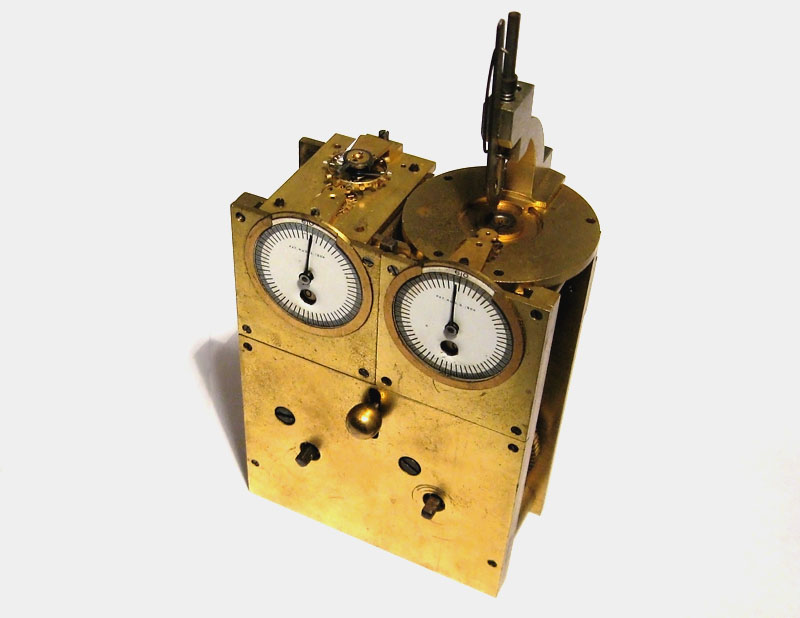
This unusual mechanical brass device 'looks' to be some sort timing or testing device, but is completely unmarked and undocumented. The mechanism consists of two brass clock movements mounted side by side, each with a 60 second dial and a subsidiary six minute dial in a small window. One movement has a fairly standard escapement platform on the top, while the other has a spring-loaded contrivance which allows a balance wheel to be quickly inserted or removed into the mechanism. A brass knob on the front resets the dials to zero when it is pulled.
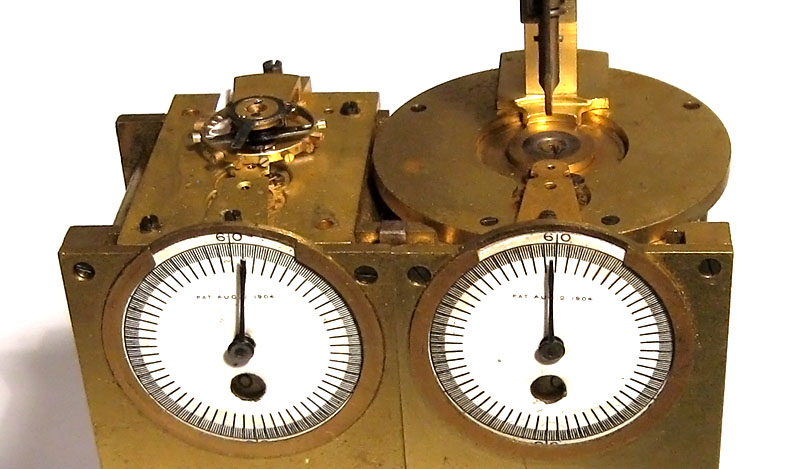
The logical assumption would be to assume this is some sort of watchmakers tool for timing balance wheels, but if so it would have significant limitations compared to the hairspring vibrators or Luthy tools typically used for the task. The clip on the right platform allows a balance wheel and hairspring to be easily inserted into the device, but the pallet fork in the platform would only interface correctly with a roller and roller gem of specific diameter. When compared to a Luthy tool, which is effective for timing balance wheels from almost any type of watch or clock, this machine can only handle balances of fairly specific dimensions. Printing on the dials indicates that this machine was patented in 1904.
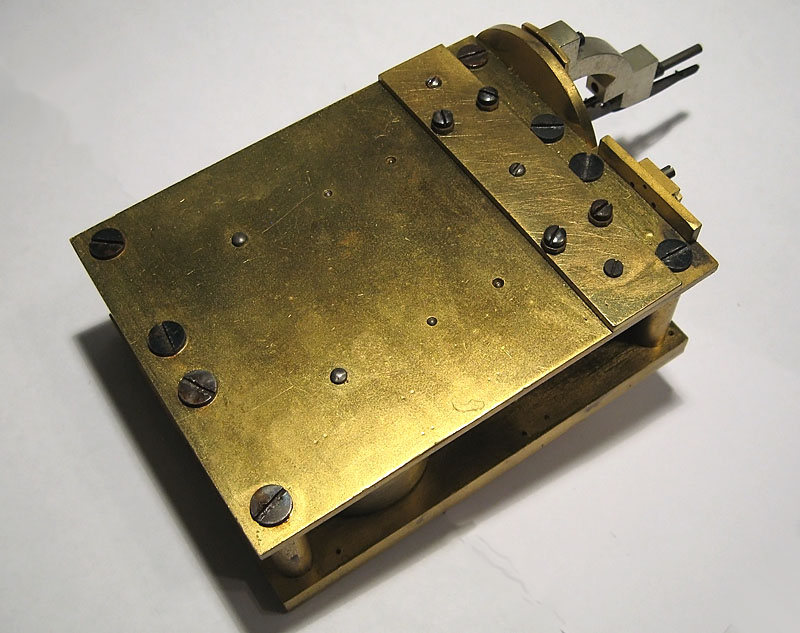
The back of this mystery device is featureless and contains no serial numbers or identifying marks. It is noteworthy that some Seth Thomas escapement platforms will fit in this machine, even though the device has no Seth Thomas makers mark.

This partially constructed device appears to be some sort of CCD or sensor, it has a large metallic bezel with an opening in one end, which lines up with a square sector on the surface of the silicon die within. The device's cavity lid has not been installed yet, and the surface of the die within is clearly visible. The octagonal frame surrounding the chip is a remnant of the manufacturing process, and would have been clipped off before the device was completed.

Under high magnification, it can be seen that the center portion of the chip has been punched or broken away, though a section of pinkish material along the bottom of the broken-out section gives some clue as to what the undamaged chip might have looked like. Note that the ball bond wires have not yet been installed between the chip package and the pads on the die.

Rarely does one encounter a device so mysterious that it cannot be immediately sorted into the bulk classification of 'tube' or 'semiconductor'. This bizarre device looks like an electron tube; it has a glass enclosure and an evacuation nipple. On closer inspection however, it appears that there is some sort of integrated circuit interloping in the center of this device, like a computer programmer magically transported into the middle of 14th century France. The object was packed in a specially fitted box with the following cryptic handwritten label; "Electro Materials Silver Epoxy 5ele Pattern".

Under higher magnification, the integrated circuit appears to be some sort of linear CCD, mounted to an angled glass post in the center of the device. The IC has seven gold leads, which exit the sides of the device and then run down the back of the glass post to the pins on the bottom of the tube envelope. The top of the tube, which is in the immediate left in the photo above, is made from a separate piece of mirrored material, which has been fused to the rest of the tube envelope.
Special thanks to Kevin Jackson for identifying the above device: "I am sure this is a sun sensor test sample for a spacecraft. It looks just like the ones used in GEO and LEO spacecraft. The sensor is placed in a slotted window so, as the spacecraft is spinning off of the launch vehicle or when thing screw up on orbit in it does auto-recover, it can sense the sun's angular position and offset from the X axis of the spacecraft, hence the row of sensors. Its sealed in a glass envelope to stop contamination during testing. I don't think this is a flight rated component but an EDU or test article with a test mounting or test connection process for a GN&C team to test with in development."


















